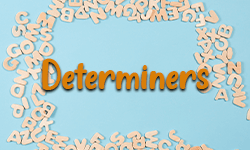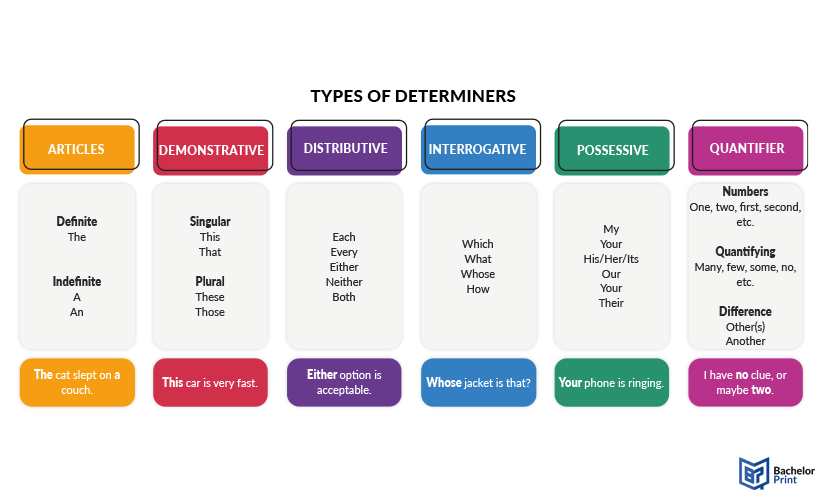
In academic writing, precision and clarity are paramount, and the proper use of grammatical elements plays a crucial role in achieving these goals. Among these elements, determiners are often overlooked components that contribute significantly to the coherence of scholarly texts. Whether you’re writing a research paper, a thesis, or an academic essay, this article will help you explore various types of determiners and their functions while offering important insights through numerous examples.
Definition: Determiners
In English grammar, the term determiner (also called “limiting adjectives”) is a functional part of speech that appears before a noun to clarify which specific noun is being referred to, how many of the nouns there are, or whose noun it is. This linguistic element helps clarify the noun’s role and meaning within a sentence by providing more essential information in terms of definiteness, quantity, possession, demonstrativeness, interrogation, or distribution. By specifying the accompanying noun, they ensure that the noun’s reference is clear and unambiguous within the context of the sentence.
Types of determiners
In total, there are six different types of limiting adjectives. We have provided several example sentences for each one and listed them as follows.
Articles always precede a noun or noun phrase, and they can be divided into two groups; indefinite and definite articles.
Definite article
The definite article “the” specifies a particular noun that is known to the speaker and listener.
Indefinite article
The indefinite articles “a” and “an” refer to a non-specific noun that can be generic.
Demonstrative determiners, also known as demonstrative adjectives, point out specific English nouns in relation to either the position of the speaker or a particular time they had mentioned them. They are closely related to demonstrative pronouns, which stand alone and replace nouns and differ from personal pronouns, which refer to specific people or things. Those include:
- This (singular)
- That (singular)
- These (plural)
- Those (plural)
Distributive determiners, or distributive adjectives, refer to members of a group individually rather than collectively. They are used within a singular noun phrase to specify that each member of the group is being addressed individually. Those include:
- Each
- Every
- Either (one of the two items/options)
- Neither (none of the two items/options)
- Both
Interrogative determiners, also called interrogative adjectives, are used to narrow down a noun’s or pronoun’s attributes by asking a question. Those include:
- Which
- What
- Whose
- How
A possessive determiner or possessive adjective indicates ownership or possession. They are closely related to personal pronouns, such as first-person pronouns, but they grammatically differ from possessive pronouns, which we have thoroughly explained in this particular article. Possessive adjectives include:
- My
- Your
- His/her/its
- Our
- Your
- Their
Quantifiers, also known as indefinite adjectives, typically follow other English determiners and provide information about the quantity of the noun. They can be divided into three groups: cardinal/ordinal, quantifying numbers, and determiners of difference.
Cardinal & ordinal numbers
Cardinal numbers are used to indicate the quantity of people or things and answer the question “How many?”. Ordinal numbers are used to specify the order of nouns in a series and answer the question “Which one?”. They include:
- One, two, three, etc. (cardinal)
- First, second, third, etc. (ordinal)
Quantifying numbers
Quantifying numbers, on the other hand, define nouns by grouping them. They include:
- Many
- Several
- Few
- All
- Some
- Both
- Any
- Enough
- No
Determiners of difference
Determiners of difference are used to highlight distinctions between or refer to additional items, people, or groups. They include:
- Other (plural countable nouns or all uncountable nouns)
- Others (can replace plural countable nouns)
- Another (singular countable nouns)
- The other (plural countable nouns)
“Other” can stand alone or after the determiners “some,” “any,” and “no.” If it’s used with a plural countable noun and one of these three quantifying numbers, “other” becomes plural. E.g., “Some students are tired, others are full of energy.”
For a more profound understanding of this subject, we have provided an illustration depicting the information mentioned above.

Determiners vs. adjectives
Descriptive adjectives are a specific type of normal adjective that focus on describing the qualities of a common or proper noun. Limiting adjectives and descriptive adjectives both provide information about nouns as we’ve seen in the previous examples. However, they serve different grammatical functions and occupy different positions within a sentence that sets them both apart. To help you know how to use them correctly, we have listed their differences below.
Placement
Limiting adjectives are usually placed in front of a common noun to specify the reference of it. However, once a descriptive adjective is added, the determiner always comes first.
Subject complements
Subject complements are words or phrases that follow a linking verb (is, am, are, was, were, be, being, or been) and describe or rename the subject of the sentence. They can be adjectives (predicative adjectives) or nouns (predicative nominatives). Determiners cannot function as subject complements, as they are used to specify nouns. Only quantifiers can sometimes be used as part of a subject complement and tend to appear more frequently in literary, poetic, or rhetorical contexts. To further your understanding, we have provided numerous examples below.
Comparative & superlative
Descriptive adjectives can change form to compare two or more nouns. These forms do not apply to limiting adjectives. However, quantifiers like “few” and “more” are an exception yet again. They both have comparative and superlative forms that function differently from true adjectives, as they specify the number and not the qualities. Here are a few examples.
Removal of the word
Compared to descriptive adjectives, determiners cannot be removed from a sentence without impacting the meaning of the sentence. While descriptive adjectives just add more imagery to subjects, determiners specify or distinguish them from others. Below, you’ll find several example sentences to illustrate this rule.
Pre-determiners
Pre-determiners are words that come before central determiners in a noun phrase. They often emphasize quantity or degree and help to give a more nuanced meaning to the noun phrase by adding a layer of specificity.
numerous advantages for Canadian students:
- ✓ 3D live preview of your configuration
- ✓ Free express delivery for every order
- ✓ High-quality bindings with individual embossing

Common mistakes
Limiting adjectives are regularly the source of common grammatical errors. These mistakes can lead to confusion and ambiguity, making it crucial to understand their correct usage. Here are some frequent errors to watch out for and tips on how to avoid them.
- Using the wrong indefinite article: Some students think that “an” is always placed before a vowel and “a” is always placed before a consonant, but this is wrong. The word sound is important and determines the indefinite article. “House” and “hour” both start with the same three letters, but the “h” in “hour” is silent, which is why it’s “a house” and “an hour.”
- Make it clear what noun you refer to: When you utilize a demonstrative adjective, it’s essential to ensure everyone understands what it refers to. This is an easy mistake to make, which is why it’s significant to double-check to avoid ambiguity.
- Wrongfully placing an apostrophe: Many possessive forms of nouns end with an “’s,” but we don’t use them with possessive adjectives. That’s the reason commonly confused words like “whose and who’s” or “its and it’s” exist.
- Using “his/her”: When you don’t know an animal’s gender, you can use “its.” However in English, we don’t use this possessive adjective for people. Instead of clumsily writing “his/her,” use the gender-neutral pronoun “their” to refer to others.
Practice sheet
Now that we went through all types, their differences, and numerous examples, it’s time to use your gained knowledge and put it to good use in this exercise. You can find the answers in the second tab.
- ___ unknown dog barked loudly in ____ park. (Indefinite & definite articles)
- ____ shoes are on sale? ____ over there. (Interrogative & demonstrative)
- ____ (she) brother is ___ talented musician. (Possessive & indefinite article)
- ____ people prefer coffee to tea. (Quantifier/quantifying number)
- ____ student has ___ copy of ____ textbook. (Distributive & articles)
- ____ (none) option seems suitable. (Distributive)
- ____ dress are you going to wear? (Interrogative)
- ____ test was ___ piece of cake. (Demonstrative & indefinite article)
- ____ of ___ (I) parents are doctors. (Distributive & possessive)
- ____ book is more interesting than ____ one. (Demonstratives)
- An unknown dog barked loudly in the park. (Indefinite & definite articles)
- Which shoes are on sale? Those over there. (Interrogative & demonstrative)
- Her brother is a talented musician. (Possessive & indefinite article)
- Some people prefer coffee to tea. (Quantifier)
- Each/Every student has a copy of the textbook. (Distributive & articles)
- Neither option seems suitable. (Distributive)
- Which dress are you going to wear? (Interrogative)
- This test was a piece of cake. (Demonstrative & indefinite article)
- Both of my parents are doctors. (Distributive & possessive)
- This book is more interesting than that one. (Demonstratives)
FAQs
Some examples are articles (the, a, an) and demonstrative adjectives (this, that, these, those).
The six determiners are articles, demonstratives, distributives, interrogatives, possessives, and quantifiers.
A determiner is in front of a noun and describes it.
The three most common ones are articles, quantifiers, and possessives.
